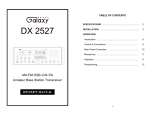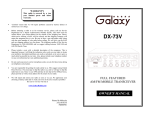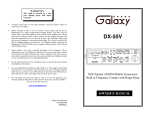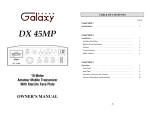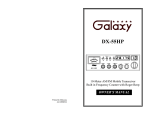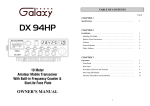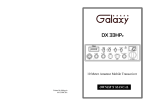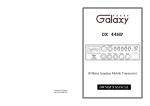Download Manual - Bells CB Radio
Transcript
DX 2517 2517 RX / TX SWR 1 0 2 2 SE 3 4 6 T 81012 1 22 WATTS POWER ON SWR 0 10 MODULAT I ON 2030 405060708090100R9 dBOVE 3 5 0+6 7 9 +20+4 0 PA FM AM USB LSB CW SIGNAL NB / ANL R.BEEP +10KHz CHANNEL NF MODE FM PA OFF CAL MICROPHONE CALIBRATE OFF OFF T.B. DIM NORMAL OFF MIC RF TIME CW BAND ECHO B A OFF RF POWER AM USB LSB C D SQUELCH VOLUME FINE COARSE PHONE E F OFF AM·FM·SSB·CW·PA Amateur Base Station Transceiver OWNER’S MANUAL TABLE OF CONTENTS SPECIFICATION : GENERAL SPECIFICATIONS ............................................................. 2 INSTALLATION ................................................................ 3 OPERATION Introduction .................................................................... 6 Control & Connections …………………………………… 6 Rear Panel Connectors …………………………………... 10 Microphone ………………………………………………… 11 Operation …………………………………………………... 11 Frequency Range Emission Types Frequency Control Frequency Tolerance Frequency Stability Temperature Range Antenna Impedance Antenna Connectors Meter Function AC Input Voltage 28.765 – 29.205 MHz CW, FM, AM, USB, LSB Phase-Lock-Loop Synthesizer 0.005% 0.003% -30OC to +55OC 50 Ohms Standard SO-239 Type Meter #1 : RF Output Power / Antenna SWR. Meter #2 : Received Signal Strength / MOD% AC 120V , 60 Hz TRANSMITTER RF Power Output Antenna Connectors AM Modulation Clarifier Range Spurious Emissions Carrier Suppression 25W : USB, LSB. 10W : AM, FM, CW UHF Type, 50 Ohms Up to 100% ±5KHz XMT & REC; ±1.5KHz REC only -60dB -60dB RECEIVER Sensitivity for 10dB S/N Sensitivity for 20dB S/N Sensitivity for 10dB S/N Adjacent Channel Rejection Image Rejection Ratio AM : 0.5uV FM : 0.25uV USB/LSB : 0.3uV -60dB -50dB AGC Figure of Merit SSB/AM : 80 dB for 50mV for 10 dB Change in Audio Output Audio Output Power @ 10% 2.5W THD (SPECIFICATIONS SUBJECT TO CHANGE WITHOUT NOTICE.) -1- -2- INSTALLATION: Antennas Location/Connection Antennas are purchased separately and include installation The transceiver should be placed in a convenient operating location instructions. Numerous type of antennas are available that range from close to an AC power outlet and the antenna lead in cable(s). emphasis on easy of installation to emphasis on performance. Often The transceiver is powered with the AC power cord set. Proceed as the difference in performance between many of the antenna is follows to complete all necessary connections to the transceiver. modest. 1. Vertical Ground Plane Antennas: 1. Your transceiver has a standard SO-239 connector on the rear These are omni-directional antennas that provide optimum panel for easy connection to standard PL-259 coax plug. If the performance for contacting other fixed stations using vertical type coax antenna cable must be made longer, use coax cable with antenna in addition to all mobile stations. For medium long range impedance of 50 ohms and use only enough cable to suit your communications work. needs. This will insure a proper impedance match and maximum 2. Directional Beam Antennas: Highly efficient and directional antennas generally intended for power transfer from the transmitter to the antenna. fixed-to-fixed very long range communications. 2. AC Power Operation: Use 120 volts AC. Remote Speaker Noise Interference The external speaker jack (EXT. SP.) on the rear panel is used for There are several kinds of noise interference you may encounter in remote receiver monitoring. The external speaker should have 8 base station operation. Some of these noise sources are; fluorescent ohms impedance and be able to handle at least 3 watts. When the buzz, external speaker is plugged in, the internal speaker is disconnected. nearby commercial broadcast, electrical appliance, lawnmower, and electrical storms, etc. Commercial products are Note: The PHONE jack on the front panel overrides both external available to reduce interference from these sources. Consult your and internal speakers. When the plug from a headphone is plugged dealer or professional amateur radio supply shops. to the PHONE jack, both internal and external speakers are silenced simultaneously. -3- -4- OPERATION: Public address An external 8 ohms, 3 Watt speaker must be connected to the PA jack located on the rear panel when the transceiver is used as a public 1 3 27 2 4 5 6 7 8 9 10 26 address system. The speaker should be directed away from the microphone to prevent acoustic feedback. Physical separation or 2517 isolation of the microphone and speaker is important when operating RX / TX the PA at high output levels. POWER ON SWR 1 0 2 2 T SE 3 4 6 81012 1 22 WATTS SWR 0 10 MODULAT I O N 2030 0 40506070809010ER 9 dBOV 0 3 5 0+6 7 9 +20+4 PA FM AM USB LSB CW SIGNAL NB / ANL R.BEEP +10KHz CHANNEL NF MODE FM RF POWER AM USB LSB CW PA OFF CAL MICROPHONE CALIBRATE OFF OFF T.B. NORMAL OFF MIC RF DIM TIME BAND ECHO B C D OFF 11 12 VOLUME 21 23 FINE COARSE PHONE F OFF 14 13 SQUELCH E A 16 17 18 15 20 19 24 25 22 INTRODUCTION This section explains the basic operating procedures for the DX 2517 amateur base station transceiver. CONTROL & CONNECTIONS: 1. POWER ON/OFF the unit. CONTROL: Push ON to apply power to 2. RF/SWR METER: This meter operates during transmit only. It reads power output or SWR. 3. SWR/CAL SWITCH: This switch is used with the “CALIBRATE” pot (No.12) to measure your SWR. Simply put this switch in the “CAL” position. Then, transmit in AM, FM or CW while adjusting the “CALBRATE” pot until the needle on the left meter goes to the small red “Notch” on the SWR scale (You may need to be at maximum power to reach the “SET” mark). Now, while still transmitting, put this switch up to the “SWR” -5- -6- position. This will give you an SWR reading. When you are finished, be sure to turn the “CALIBRATE” pot fully CCW to the “RF” position so you are able to read your output power. You will hear the “RF” switch click on. 4. NB/ANL SWITCH: This switch controls the Noise Blanker and Automatic Noise Limiter simultaneously. They are turned on and off together. The noise Blanker is very effective for eliminating repetitive impulse noise such as ignition interference. The Automatic Noise Limiter reduces strong atmospheric or manmade interference. 5. ROGER BEEP SWITCH: When this switch is placed in the ROGER BEEP position, the radio automatically transmits an audio tone at the end of your transmission so that people who are having trouble hearing you will know that you are done speaking. As a courtesy to others, use the Roger Beep only when necessary. 6. NOISE FILTER: This filter de-emphasizes audio high frequency response in order to increase the signal-to-noise ratio of weak signals. While you will notice a dramatic reduction in the “rushing” sound when this filter is activated., it does not have much effect on the signal-to-noise ratio of strong signals. 7. +10KHz SWITCH: This switch adds 10KHz to the frequency being used. Example, if frequency counter display 28.765, flip the switch and the display will read 28.775MHz. 8. SIGNAL/MODULATION METER: This meter indicates signal strength of incoming signals during receive and your percentage of modulation when transmitting in the AM. Modulation readings are most accurate when using maximum output power. The modulation meter does not work at all in FM or SSB. -7- 9. CHHANEL DISPLAY: The channel display indicates the current selected channel. 10. FREQUENCY COUNTER: The frequency counter indicates the frequency of operation. 11. MICROPHONE JACK: Used to connect microphone for voice source. 12. CALIBRATE CONTROL: In the “RF” position, the left meter reads power output in watts. When rotated clockwise, it is used in conjunction with the “SEW/CAL” switch (No.3). 13. DIM CONTROL: Controls the brightness of the meter lamps and display digits. 14. TALK BACK: This is a switched pot that controls the volume of the talkback sound. It does not affect the sound your transmitting. You can turn the talkback off (Fully CCW) or adjust the volume as you desire. This talkback circuit can be used anytime – even without any sound effects. 15. RF GAIN CONTROL: This control is used to reduce the gain of the RF amplifier under strong signal conditions. 16. MIC GAIN CONTROL: This control adjusts the microphone gain in the transmit mode. This feature is designed for use in a high-ambient noise environment or to maximize talk power. 17. TIME/ECHO CONTROL: This “TIME” control pot turns the ECHO on and off and is used to set the time delay of the ECHO repetitions. The ECHO control sets the intensity of the ECHO effect. -8- 18. CHANNEL SELECTOR: This control is used to select a desired frequency. 26. MODE LED INDICATORS: The lighted LED indicates which mode the radio is in. 19. MODE CONTROL: This control allows you to select one of six operating modes: PA/FM/AM/USB/ LSB/CW 27. RX/TX LED: Lights green during receive and changes to red during transmit. 20. BAND SELECT SWITCH: This switch is allow the user to select the desired band. REAR PANEL CONNECTOR: 21. SQUELCH CONTROL: This control is used to control or eliminate receiver background noise in the absence of incoming signal. For maximum receiver sensitivity, it is desired that the control be adjusted only to the point where the receiver background noise is eliminated. Turn fully counterclockwise, then slowly clockwise until the receiver noise disappears. Any signal to be received must now be slightly stronger than the average received noise. Further clockwise rotation will increase the threshold level which a signal must overcome in order to be heard. Only strong signal will be heard at a maximum clockwise setting. 22. RF POWER: This control is used to adjust the RF power output level you want in AM or FM transmission. 23 VOLUME CONTROL: Permits you to adjust the listening level when receiving. 7 8 1 1. 2 3 4 5 6 AC POWER CORD : Connects to AC power outlet for AC mains supply. 2. FUSE : Accommodates a fuse for AC input circuit protection. Use 125V/7A fuse for replacement. 24. COARSE/FINE CONTROL: The “COARSE” control adjusts the frequency ±5.0KHz in receive and transmit. The “FINE” control adjusts the frequency ±1.5KHz in receive only. This comes in handy when tuning in someone who is “OFF” frequency compared to everyone else. 3. EXTERNAL SPEAKER: This jack accepts 4 to 8 ohms, 5 watt external speaker. When the external speaker is connect to this jack, the built-in speaker will be disabled. 4. PA SP: Used to connect a PA speaker (8 Ohm 4w) for PA operation. Before operating PA you must first connect a PA speaker to this jack. 25. PHONE JACK: Accepts a plug from a headset of 4 to 32 Ohm impedance. 5. ANTENNA: This jack accepts 50 ohm coaxial cable with a type PL-259 plug to be connected. -9- - 10 - 6. REC JACK: The RCA-type (pin) jack provides audio output for connection to a tape recorder. This can be used to record incoming signals or your voice when transmitting. 8. FREQUENCY COUNTER JACK: The RCA-type jack provides a signal used by some frequency counters so you can read the frequency digitally. This readout signal operates on transmit only. 4. CW KEY: Use for Morse Code operation. Connect a CW key to this jack and place the MODE switch in the CW position. MICROPHONE: The receiver and transmitter are controlled by the push-to-talk switch on the microphone. Press the switch and the transmitter is activated, release switch to receive. To transmit, hold the microphone about two inches from your mouth and speak clearly in a normal voice. The radio comes complete with a low impedance dynamic microphone. OPERATION PROCEDURE A. PROCEDURE TO RECEIVE 1. Make sure that the power cord, microphone and antenna are connected properly. 2. Turn the volume down to about the nine o’clock position. 3. Set the mode switch. 4. Push the power switch on. The meter and display LED’s should light up unless the dimmer control is set too low. 5. Select the desired frequency. 6. Adjust the receive gain for maximum. 7. Set the squelch as desired. 8. Use the “COARSE/FINE” control as necessary to tune signals in properly. - 11 - B. PROCEDURE TO TRANSMIT 1. Set the MIC gain fully clockwise. 2. Press the push-to-talk switch on the microphone and speak directly into the microphone. 3. Adjust the MIC gain down if the person you are talking to says your are too loud. C. MICROPHONE GAIN CONTROL A preamplifier circuit is built into the radio to increase the microphone gain. Experiment with the control for setting that will best suit your individual use. Note: When the microphone gain control is set to maximum, ambient noise may also be picked up by the microphone. In high noise situations, low microphone gain setting may produce the best results. The microphone gain control is also used to adjust PA loudness. D. PUBLIC ADDRESS OPERATION To use this feature of the transceiver, a speaker having a voice coil impedance of 8 to 16 Ohms and power handing capability of least 3 watts should be connected to the PA SP jack on the rear panel. Be sure that there is physical separation between the microphone and the PA speaker itself. If the PA speaker is located very close the microphone, acoustic feedback will result when the PA amplifier is operated at high volume (or when PA is used indoor). Adjustment of PA volume is made with MIC GAIN control. E. S.W.R MEASUREMENT Most antenna are factory tuned, but the antenna efficiency may be peaked by slightly adjusting the length of antenna using the SWR meter built into the unit. This adjustment may improve the antenna standing wave ratio (SWR). The SWR permits you to determine how well matched the antenna and its cables are to your transceiver. - 12 - 1. Set the unit in the receive mode as instructed under the operating procedure to receive section. 2. Set the mode switch to AM position, the SWR-CAL switch to the CAL position. 3. Press the push-to-talk switch on the microphone and turn the calibrate control clockwise (past click) so that the SWR meter pointer exactly coincides with the set mark on the scale. Release the push-to-talk switch. 4. Set the SWR-CAL switch to the SWR position and depress the push-to-talk switch again. The SWR of your antenna is read directly on the scale. WARRANTY This radio has a one year parts and labor warranty. For warranty service, please contact your dealer. BE SURE TO VISIT OUR WEB SITE AT: www.galaxyradios.com - 13 - - 14 - PRINTED IN TAIWAN AT0SSB010W - 15 -









